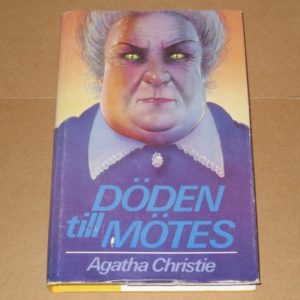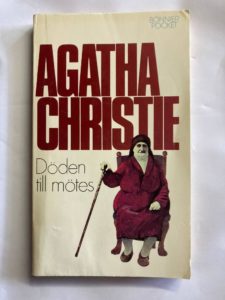I rescued this book from a “free to take” box along the sidewalk after a run sometime in summer 2020? 2021? What is time? Along with Miss Marples sista fall, because I can never say no to a free book, especially if it’s Agatha Christie.
There’s a Rian Johnson Tweet somewhere about how Christie’s novels are anything but formulaic and how she used the mystery novel as a front for experimenting in all kinds of other genres:
Something I love about Agatha Christie is how she never tread water creatively. I think there’s a misperception that her books use the same formula over and over, but fans know the opposite is true. It wasn’t just settings or murder methods, she was constantly stretching the genre conceptually. Under the umbrella of the whodunnit she wrote spy thrillers, proto-slasher horrors, serial killer hunts, gothic romances, psychological character studies, glam travelogues.
This element of Christie’s writing eluded me in my middle school whodunnit phase, but I think you can forgive a 12-year-old for not considering the finer points of genres like spy thrillers.
This quote came to mind as I was reading Döden till mötes (Appointment With Death), as did the fact that Christie rather famously couldn’t abide her fan-favorite protagonist. Appointment With Death came out in 1938, so there were still other Poirot books and stories to come, but already you can see Christie sidelining the Belgian detective as much as possible in order to tell another story.
Most of the book happens without Poirot present and, as Johnson’s observation above suggests, is a combination of gothic romance (the mysterious and alluring Raymond Boynton trapped by a domineering stepmother and protagonist Sarah King’s determination to rescue him) and glam travelogue (Christie’s eye for character is also turned to the landscapes of Jerusalem and Petra). And as far as that story goes, it’s…fine but dated. Anything set in Jerusalem these days is just going to come across as oof, to use a technical term. Even without the “aged like milk” setting, there’s a lot of surface-level psychoanalysis from the French psychologist Dr. Gerard that is meant to be narratively sound, and maybe even came across as reasonable and plausible in 1938, but today reads like pompous buffoonery.
On the other hand, Christie has a few conversations and observations that are still timely 80-odd years later. I don’t remember her roasting women quite so thoroughly in other books, but it’s been a while since I’ve read any so who can say. We have the tyrannical murder victim, Mrs. Boynton, who is quickly established as a vile and hideous creature through and through (the book never lets us forget that she’s fat!)*; we have the tiresome but accomplished Lady Westholme who is constantly the butt of everyone’s jokes, both for her domineering personality as well as her unattractive looks (powerful Hillary Clinton energy); and scatter-brained Miss Pierce is more or less dismissed by everyone. The golden mean of all three of these seems to be protagonist Sarah King, who can neither abide the airheaded Miss Pierce but who also finds Lady Westholme too much. As a result, King feels like a mouthpiece for Christie’s own opinions about women’s place in the world.
As for the whodunnit itself, it’s clever (to be expected!) but not as satisfying as other Christie novels. Some bits I untangled right away; other asides are dropped in that sound like they’re set up for a big reveal, but ultimately they just fizzle and go nowhere.
The Swedish translation is a job well done, though perhaps it’s easier to convey Agatha Christie in Swedish than Elmore Leonard. Regardless, Einar Thermaenius succeeded where Einar Heckscher failed; while my copy was fairly old, even new Swedish editions of Agatha Christie today are often still Thermaenius’s translation (his translation of The ABC Murders from 1938 saw an eleventh printing in 2015). Even “new translations” of Thermaenius (and others) are more often new edits of old translations rather than entirely new translations. Why mess with perfection?
*And a weird postscript to that. The English book covers all have covers that feature the landscape, elements of the plot, or spooky murder imagery unrelated to the actual story. It took a fair bit of scrolling to find one older example of a cover featuring Mrs. Boynton herself, and then rendered fairly neutrally:

It took me zero seconds and zero scrolling to find much less flattering Swedish portrayals of Mrs. Boynton:
 |
 |
Are…are you OK, Sweden? Who hurt you?

